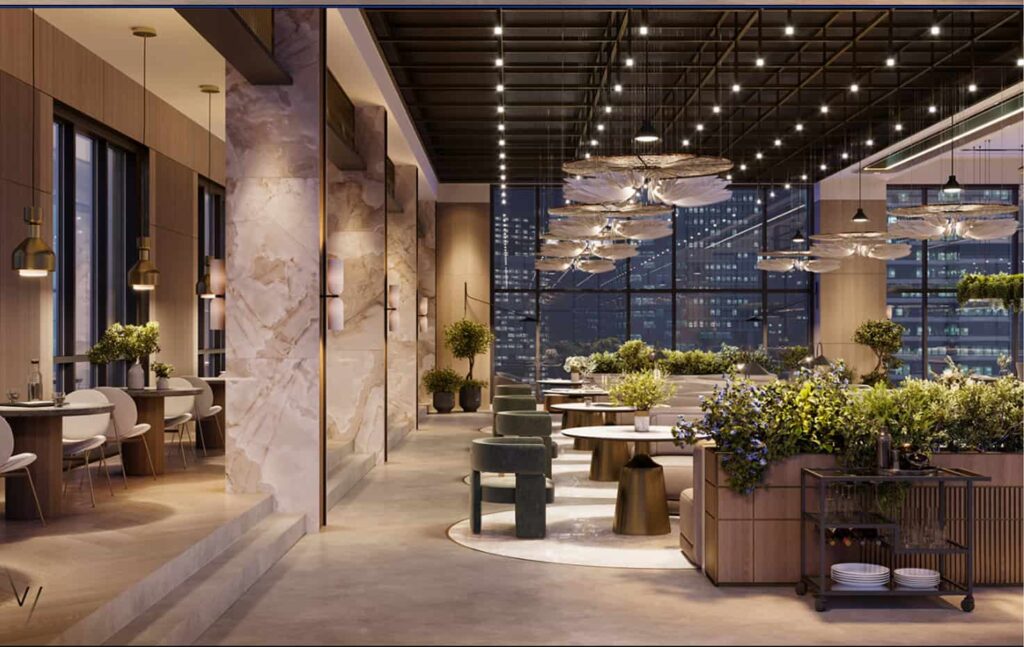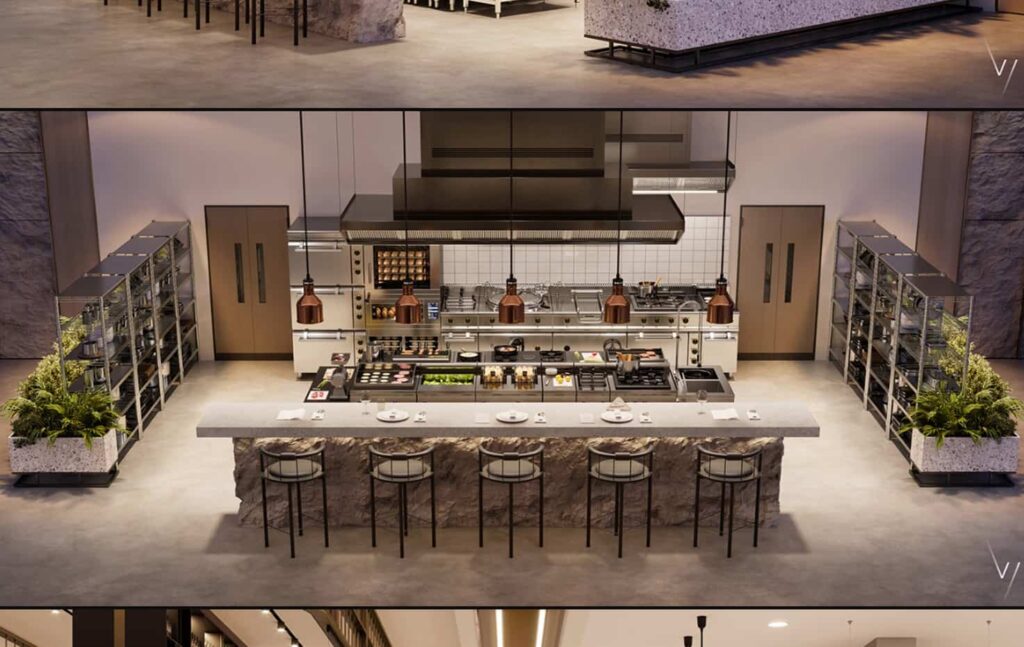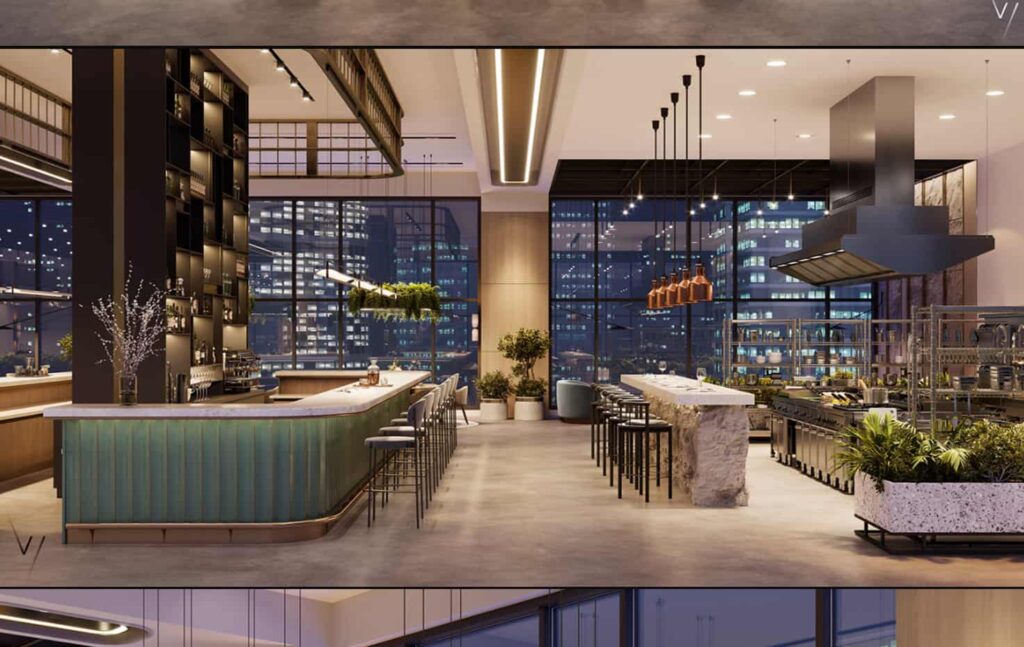Introduction
Overview of Big Restaurant Interior Design
Big restaurant interior design plays a pivotal role in shaping the dining experience in Bangladesh. Large restaurants must balance multiple elements—comfort, style, and operational efficiency—to accommodate a high volume of customers. In a country with a growing restaurant culture, especially in cities like Dhaka, Chittagong, and Sylhet, aesthetic restaurant interior design has become a crucial factor for success. Restaurant decorating ideas have become essential to attract more diners and enhance their dining experience.
Growing Restaurant Industry in Bangladesh
The restaurant scene in Bangladesh is flourishing, with a growing demand for large venues capable of hosting families, corporate groups, and social events. As the competition intensifies, restaurants must set themselves apart through creative and well-thought-out interior designs. This includes balancing aesthetics with functionality to ensure an efficient and comfortable environment for guests. Working with a professional restaurant interior designer can provide the expertise needed to bring these ideas to life.
The Importance of Comfort in Big Restaurant Interior Design
Creating Comfortable Dining Spaces
An aesthetic restaurant interior design prioritizes comfort, ensuring customers enjoy their meals in a relaxed and pleasant environment. In large restaurants, creating diverse seating arrangements that cater to both intimate dinners and more prominent group gatherings is essential. Restaurant decorating ideas that incorporate comfort can significantly impact customer satisfaction.
Key Points:
- Comfortable seating options, such as plush chairs and ergonomic booths, help guests feel at ease.
- Spacious designs, with enough room for guests to move around, contribute to a relaxing atmosphere.
Ergonomics and Seating Comfort
Choosing ergonomically designed furniture is vital, especially in large spaces. The seating must provide support for extended dining experiences while maintaining aesthetic appeal. Professional restaurant interior designers understand how to blend comfort with style.
Solutions for Various Needs:
- Comfortable chairs and adjustable seating can accommodate families, groups, or solo diners.
- Incorporating seating types that suit different dining preferences, like booths, communal tables, and lounge areas.
Temperature and Ventilation Considerations
In the tropical climate of Bangladesh, ensuring a comfortable temperature inside large restaurants is paramount. HVAC systems must be efficient to maintain a pleasant atmosphere. Natural ventilation, combined with air conditioning, helps achieve an ideal indoor climate.

Incorporating Style and Aesthetics in Big Restaurant Interior Design
Design Theme and Concept
A unique design theme enhances the ambiance and creates a memorable dining experience. Whether modern, rustic, or industrial, the theme must reflect the restaurant’s personality and target market. Creative restaurant decorating ideas can elevate the overall experience.
Design Considerations:
- A modern aesthetic might incorporate sleek lines and contemporary furniture.
- A rustic theme might use natural wood, stone accents, and earthy tones.
Local and Global Design Influences
Bangladesh’s rich culture can be integrated into restaurant designs through traditional crafts like Jamdani fabrics, terracotta, and intricate woodwork. Combining these elements with global design trends helps create a balanced, unique aesthetic. A skilled restaurant interior designer can merge local and international influences seamlessly.
Fusion Design:
- Local Bangladeshi elements such as traditional wall art can be paired with modern design concepts like minimalist furniture or open kitchen concepts.
- International design trends, such as industrial chic or Scandinavian style, can be adapted to suit local tastes.
Art and Décor to Enhance Ambience
Art and décor play an essential role in enhancing the restaurant’s vibe. Murals, sculptures, and local artwork can amplify the restaurant’s theme and create a deeper connection with the culture.
Key Tips:
- Choose décor that complements both the space and overall theme.
- Artwork and sculptures can add a personal touch and draw attention to specific areas.
Ensuring Efficiency in Big Restaurant Interior Design
Space Planning and Layout Optimization
In large restaurants, effective space planning ensures efficient use of the available area. Layouts should provide ample space for diners while allowing efficient movement for staff. Professional restaurant interior designers excel at optimizing layouts for maximum functionality.
Key Elements:
- Clearly defined dining areas, bars, and kitchens.
- Traffic flow that avoids congestion and ensures guests can easily access their seats.
Flow and Accessibility
Good design also ensures that traffic flow within the restaurant is smooth. Efficient pathways should lead customers through the venue without obstruction. Accessibility for all patrons, including those with disabilities, is essential.
Practical Tips:
- Wide walkways and ramps should be included to allow smooth movement for both guests and staff.
- The seating and tables should be placed thoughtfully for easy access.
Efficient Lighting and Energy Use
Lighting in large venues must serve both practical and aesthetic purposes. A well-lit restaurant creates a warm, inviting atmosphere, while energy-efficient lighting solutions minimize operational costs. Incorporating restaurant decorating ideas that include energy-efficient lighting can also lower long-term operational expenses.
Key Considerations:
- Use a combination of natural lighting during the day and ambient lighting during the evening.
- Incorporate energy-saving solutions like LED lights to reduce costs.
The Role of Technology in Big Restaurant Design
Smart Technologies for Improved Operations
Technology plays a key role in modern restaurant design. Digital menus, POS systems, and kitchen display systems can streamline operations and enhance customer experience. A restaurant interior designer may recommend integrating these technologies into the design.
Examples:
- Digital ordering systems reduce wait times and improve order accuracy.
- Automated lighting and temperature control systems create a more energy-efficient environment.
Sustainability and Energy Efficiency
Sustainability is a growing concern, and many large restaurants in Bangladesh are embracing eco-friendly practices. Energy-efficient appliances, sustainable materials, and waste-reduction strategies are now incorporated into interior design.
Sustainable Practices:
- Use of recyclable materials for furniture and décor.
- Energy-efficient lighting and appliances help reduce carbon footprint.
Challenges in Designing Large Restaurants in Bangladesh
Balancing Aesthetics with Functionality
Designing a large restaurant involves the challenge of balancing aesthetic appeal with functional requirements. Ensuring that both the design looks good and serves its operational needs is key. Restaurant decorating ideas can help overcome this challenge by offering creative solutions.
Challenges:
- Ensuring there is enough space for high customer volumes while maintaining an inviting atmosphere.
- Combining both local and international design trends in a way that appeals to a diverse audience.
Space Constraints in Urban Settings
In cities like Dhaka, space is often limited, which presents a challenge in designing large venues. Creative use of available space is crucial in such settings. A restaurant interior designer can make the most of the space available.
Space Solutions:
- Vertical designs or multi-level layouts can optimize limited space.
- Modular furniture can be adapted to different group sizes.
Cultural Sensitivity and Customer Preferences
Understanding local culture and customer preferences is essential when designing a big restaurant. The interior design should reflect local aesthetics and dining habits while incorporating international trends.
Cultural Considerations:
- Offering a family-friendly space, including private dining sections and communal tables.
- Reflecting the cultural diversity of Bangladesh through diverse design elements.

Design Trends for Big Restaurants in Bangladesh
Minimalism and Modernity
Minimalism and modern design are becoming popular trends in big restaurant interior design. Using clean lines, sleek surfaces, and functional spaces allows for an open and airy atmosphere. Restaurant decorating ideas that incorporate minimalist principles can make a restaurant feel spacious and welcoming.
Integration of Nature-Inspired Elements
Incorporating greenery and natural elements is a growing trend. Indoor plants, living walls, and outdoor seating areas create a refreshing, natural ambiance that resonates with diners.
Multi-functional Spaces and Versatility
Large restaurants must be versatile to cater to different functions—be it casual dining, private events, or parties. Multi-functional spaces are designed with flexibility in mind.
Real-Life Examples of Big Restaurant Interior Design in Bangladesh
Case Study 1: A Modern Restaurant in Dhaka
A high-end restaurant in Dhaka combines modern design elements with functional features. The spacious layout, contemporary lighting, and elegant décor create a sophisticated dining atmosphere.
Case Study 2: A Family-Friendly Restaurant in Chittagong
This large venue in Chittagong offers a cozy, family-friendly atmosphere with a blend of local culture and modern design. Comfortable seating and vibrant artwork create a welcoming vibe.
Case Study 3: A Luxury Dining Experience in Sylhet
A luxurious restaurant in Sylhet merges traditional Bangladeshi designs with contemporary aesthetics. The stylish interiors, including elegant woodwork and sophisticated lighting, provide an upscale dining experience.
Conclusion
Summarizing the Key Design Elements
Big restaurant interior design in Bangladesh is about finding the right balance between comfort, style, and efficiency. Thoughtful design can elevate the dining experience and create a lasting impression. Incorporating restaurant decorating ideas can ensure the space is both functional and visually appealing.
Final Thoughts on Restaurant Design Trends
Encouraging restaurant owners to incorporate modern trends, local cultural elements, and sustainable practices can help create an inviting and functional space that attracts more customers. Working with a professional restaurant interior designer can make all the difference in achieving a cohesive design.
FAQs
-
What is the importance of space planning in big restaurant interior design?
- Effective space planning ensures an efficient flow of customers and staff while maximizing the use of available space. Clear zoning helps improve the overall dining experience.
-
How can local cultural elements be incorporated into restaurant designs?
- Integrating traditional Bangladeshi elements, such as Jamdani fabrics, terracotta, and wooden accents, creates a unique identity and connects with the local community.
-
What are some energy-efficient solutions for large restaurant designs?
- Implementing energy-saving features such as LED lighting, smart temperature control, and eco-friendly materials can reduce operational costs and environmental impact.
-
How can technology enhance a restaurant’s interior design?
- Technology, such as digital menus, POS systems, and automated lighting, can streamline restaurant operations while improving the customer experience.
-
What are some common design challenges for large restaurants in Bangladesh?
- Some challenges include balancing aesthetics with functionality, working with limited space in urban areas, and incorporating both local and global design influences.

